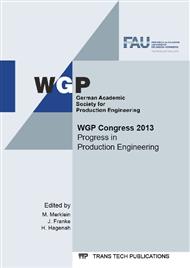[1]
S. Tour, L.S. Fletcher, Hot Spot Machining. Iron Age vol. 164 (1949) 78-89.
Google Scholar
[2]
E.T. Armstrong, A.S. Cosler, E.F. Katz, Machining of Heated Metals. Soc. Mech. Engrs. Vol. 73 (1951) 35-43.
Google Scholar
[3]
E.J. Krabacher, M.E. Merchant, Basic factor of hot machining of metals. Journal of Engineering for Industry, Transactions of the ASME 73 (1951) 761–776.
DOI: 10.1115/1.4016424
Google Scholar
[4]
S. Rajagopal, D.J. Plankenhorn, V.L. Hill, Machining aerospace alloys with the aid of a 15 kW laser. Journal of Applied Metalworking 2 (1982) 170–184.
DOI: 10.1007/bf02834035
Google Scholar
[5]
G. Madhavulu, B. Ahmed, Hot machining process for improved metal removal rates in turning operations. Journal of Materials Processing Technology 44 (1994) 199–206.
DOI: 10.1016/0924-0136(94)90432-4
Google Scholar
[6]
C.E. Leshock, J.-N. Kim, Y.C. Shin, Plasma enhanced machining of Inconel 718: modeling of workpiece temperature with plasma heating and experimental results. International Journal of Machine Tools and Manufacture 41 (2001) 877–897.
DOI: 10.1016/s0890-6955(00)00106-1
Google Scholar
[7]
M.A. Lajis, A.K.M.N. Amin, A.N.M. Karim, H.C.D.M. Radzi, T.L. Ginta, Hot machining of hardened steels with coated carbide inserts. Am. J. of Eng. and App. Sciences 2 (2009) 421–427.
DOI: 10.3844/ajeassp.2009.421.427
Google Scholar
[8]
G. Barrow, Machining of high strength materials at elevated temperature using electrical current heating. CIRP Annals 14 (1966) 145–151.
Google Scholar
[9]
O.W. Dillon, R.J. De Angelis, W.Y. Lu, J.S. Gunasekera, J.A. Deno, The effects of temperature on the machining of metals. J. Materials Shaping Technology Vol. 8, No. 1 (1990) 23-29.
DOI: 10.1007/bf02834790
Google Scholar
[10]
A.K.M.N. Amin, S.B. Dolah, M.B. Mahmud, M.A. Lajis, Effects of workpiece preheating on surface roughness, chatter and tool performance during end milling of hardened steel D2. Journal of Materials Processing Technology 201 (2008) 466–470.
DOI: 10.1016/j.jmatprotec.2007.11.304
Google Scholar
[11]
Y.C. Shin, J.-N. Kim, Plasma enhanced machining of Inconel 718. American Society of Mechanical Engineers, Manufacturing Engineering Division MED Vol. 4 (1996) 243-249.
Google Scholar
[12]
M. Anderson, R. Patwa, Y.C. Shin, Laser-assisted machining of Inconel 718 with an economic analysis. International Journal of Machine Tools and Manufacture 46 (2006) 1879–1891.
DOI: 10.1016/j.ijmachtools.2005.11.005
Google Scholar
[13]
P. Dumitrescu, P. Koshy, J. Stenekes, M.A. Elbestawi, High-power diode laser assisted hard turning AISI D2 tool steel. Int. J. of Machine Tools and Manufacture 46 (2006) 2009–2016.
DOI: 10.1016/j.ijmachtools.2006.01.005
Google Scholar
[14]
H. Attia, S. Tavakoli, R. Vargas, V. Thomson, Laser-assisted high-speed finish turning of superalloy Inconel 718 under dry conditions. CIRP Annals – Man. Tech. Vol. 59/1 (2010) 83-88.
DOI: 10.1016/j.cirp.2010.03.093
Google Scholar
[15]
J.W. Novak, Y.C. Shin, F.P. Incropera, Assessment of plasma enhanced machining for improved machinability of Inconel 718. Journal of Manufacturing Science and Engineering,Transactions of the ASME 119 (1997) 125–129.
DOI: 10.1115/1.2836550
Google Scholar
[16]
F. Klocke, T. Bergs, Laser-Assisted Turning of Advanced Ceramics. Proceedings of SPIE: Rapid Prototyping and Flexible Manufacturing 3102 (1997) 120-130.
DOI: 10.1117/12.281309
Google Scholar
[17]
S. Lei, F. Pfefferkorn, A review of thermally assisted machining. Proceedings of the ASME Int. Conference on Manufacturing Science and Engineering, Atlanta, GA, October 15-18 (2007) 1–12.
DOI: 10.1115/msec2007-31096
Google Scholar
[18]
S. Sun, M. Brandt, M.S. Dargusch, Thermally enhanced machining of hard-to-machine materials – A review. International Journal of Machine Tools & Manufacture 50 (2010) 663–680.
DOI: 10.1016/j.ijmachtools.2010.04.008
Google Scholar
[19]
B.-A. Behrens, W. Bleck, Fr.-W. Bach, E. Brinksmeier, U. Fritsching, M. Liewald, H.-W. Zoch, EcoForge: Resource-efficient process chains for high performance parts, Key Engineering Materials, Vols. 504-506 (2012) 151-156.
DOI: 10.4028/www.scientific.net/kem.504-506.151
Google Scholar


